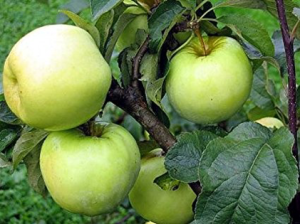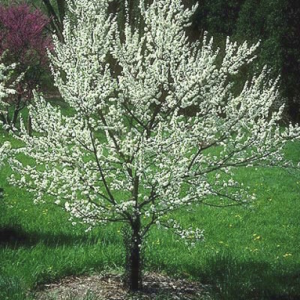Choosing Rootstock
When choosing rootstock I recommend looking beyond the trees’ use as a rootstock and looking at the usefulness of the tree as a whole. When I choose rootstock I like to select ones with multiple uses, Wild Plum and Antonovka Apple are clear winners in my book. Not only do they make great rootstock for grafting because of their cold hardiness, adaptability, and disease resistance (great reasons to use them as rootstock); but they are good trees in their own right. The many uses of Antonovka Apple and Wild Plum are amazing. Let’s take each tree in turn.
Antonovka Apple
 Antonovka is an apple cultivar, very popular in Russia, known for its cold-hardiness and strong acidity. It makes great option when choosing rootstock for cold climates. Labeled a standard-sized tree which means increased stability, a deep taproot, and drought tolerance. If you don’t mind using a larger tree as rootstock this is a great choice, and you can always prune it to keep it a more manageable size. However, there are many reasons that the Antonovka Apple tree is a very versatile tree on its own:
Antonovka is an apple cultivar, very popular in Russia, known for its cold-hardiness and strong acidity. It makes great option when choosing rootstock for cold climates. Labeled a standard-sized tree which means increased stability, a deep taproot, and drought tolerance. If you don’t mind using a larger tree as rootstock this is a great choice, and you can always prune it to keep it a more manageable size. However, there are many reasons that the Antonovka Apple tree is a very versatile tree on its own:
- its fruit stores for long periods of time
- it is good for fresh eating
- it is very good for baking due to its high acidity
- it is a popular choice for making apple wine and apple cider
- wildlife and/or livestock can eat it to supplement their feed
- it grows true from seed which is very unusual in the apple world
On our homestead we planted Antonovka in our pig paddocks, agroforestry experimental area, and we are using it as our rootstock of choice for our other apple cultivars. Another significant advantage of growing Antonovka is the fact that you can buy the rootstock very inexpensively. With that said, you’re likely to get a one or two year tree that is small, with a 3/16’ – 1/4” diameter whip. In the end, it is a great choice to add this to your homestead.
The Many Uses of Wild Plum
Wild plum or America Plum is native to North America. It is used as a cold-hardy rootstock for American and American/Japanese cross cultivars. It is also been known as a successful rootstock for peaches, apricots and pluots. The Wild Plum spans a wide range of growing conditions and will tolerate most soils. The fruit was used by Native Americas extensively as a food and medicine. Wild Plum is astringent and a sedative. The bark is a tonic. The roots have also been used as a red dye. The fruit produced is not large, the plums are only about 1” but the tree is suitable for:
- fresh eating
- jams & jellies
- fruit leather
- plum wine
- food for people
- habitat for wildlife or windbreak because it tends to form thickets
- beautiful ornamental
- feed for wildlife and livestock
- natural medicine
Furthermore, you can get more rootstock! Just like Antonovka it is also very inexpensive to buy and to use both as rootstock and a fruit tree in its own right.
These are just two examples of trees I would consider when choosing rootstock. An important permaculture principle to remember when making your choice is to select items (whether they are trees, buildings, or any other resource) that provide multiple functions. Both of these trees fit the bill!






Leave a Reply
You must be logged in to post a comment.